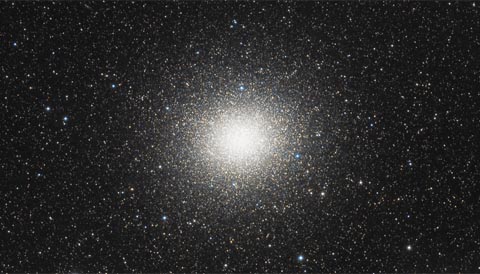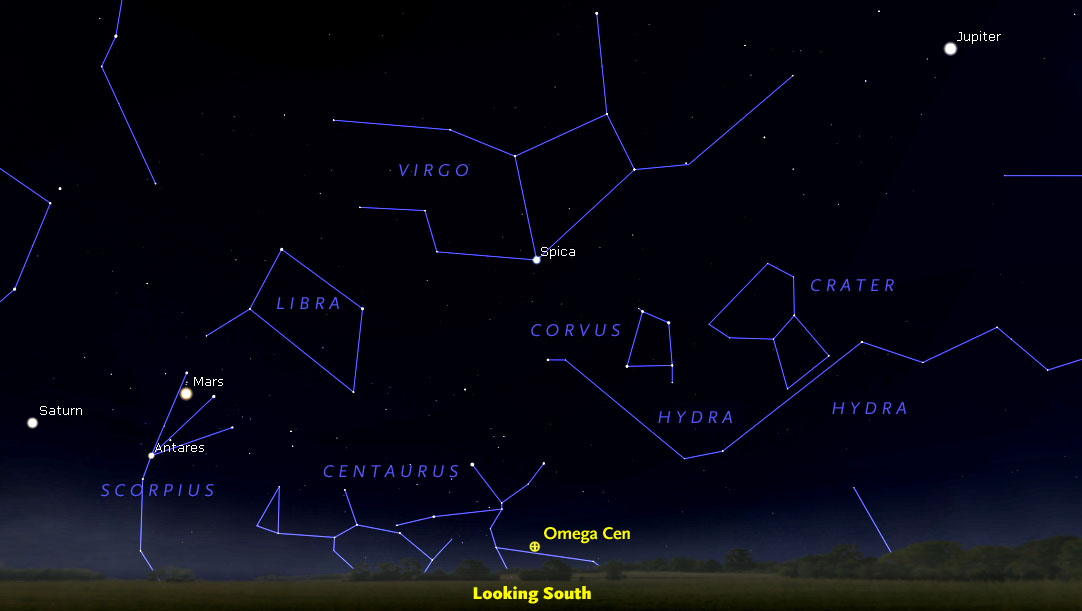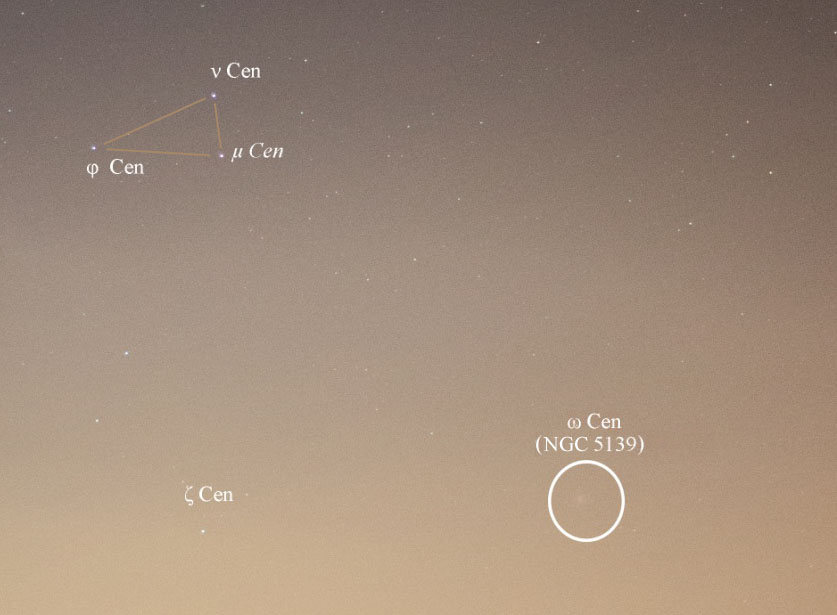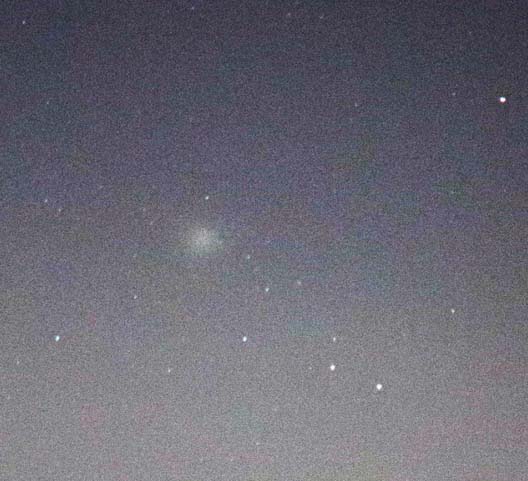The immense Omega Centauri is widely regarded as the most impressive globular cluster in the sky. Its deep southern location makes this object challenging to spot — but it can be done, as Italian observer Giuseppe Pappa explains.
Around mid-May to early June, the approach of northern summer means the nights become short. But the evening sky continues to show a lot of interesting deep-sky objects of all kinds. For those who live around mid-latitudes (35° to 40° north), the Big Dipper is high in the north after sunset, while Arcturus and Spica shine toward south. This year bright Jupiter is also passing through Leo, and Mars, near opposition, is easy to spot in the east.

Dan Crowson
Among the various objects in view at this time, one has a particular appeal for me because it is the biggest globular cluster visible in the sky: Omega (ω) Centauri or NGC 5139. Having a mass of perhaps 5 million suns, Omega Cen is 10 times more massive than a typical globular cluster — and it’s 230 light-years across.
This object got the name “Omega” inadvertently. It was first mentioned in AD 150 by Ptolemy, who referred to it as a star on a horse’s back. Much later, Johannes Bayer used Greek letters to designate stars in his famous Uranometria, published in 1603, and he assigned Omega to this “star” in Centaurus. When Edmond Halley rediscovered this object in 1677, he described it as the nonstellar telescopic object we now know it to be.
Several studies reveal that Omega Centauri has different stellar populations that formed at varying periods of time, unlike the situation with other globulars. So some astronomers suspect that this object is a remnant of a small dwarf galaxy that merged with the Milky Way.

Source: Stellarium
Omega Cen has a declination of –47½°, and it’s easily seen by eye as a fuzzy star from the Southern Hemisphere. But here in the north, it only barely clears the southern horizon, if at all, and can only be seen at certain times of the year. The most convenient time to see it in the evening sky is from May to June around 10 or 11 p.m. (That corresponds to about 1 a.m. in mid-April and 3 a.m. in mid-March.)

Giuseppe Pappa
You have a chance if your latitude is no farther north than 40°. Depending where you live, Omega Centauri culminates over the southern horizon with an altitude of 5° to 10°. So, to see it, you’ll need a very clear and dark sky without haze or much light pollution.
Start your search for this spectacular object with Spica, the brightest star in Virgo. Spica and Omega Centauri have nearly identical right ascensions, so they transit the north-south meridian in unison — except that Omega Cen is about 35° below Spica.

Giuseppe Pappa
I took the pictures shown here last year from Sicily. The one above gives a good impression of what you might see by eye. With a good eyesight and careful attention, you can spot what appears to be an object that’s not starlike but a small fuzzy ball (which, in reality, contains billions of stars).
The second image, taken with a DSLR camera and a 300-mm lens, gives a decent impression of how Omega Centauri looks when as seen with binoculars. As you can see it is visible despite the skyglow from a city. With typical 10×50 binoculars it becomes a fantastic sight, with a lot of stars concentrated in very little area. With a telescope you can resolve more and more stars.
So try to find Omega Centauri yourself — and maybe it will become one of your favorite targets too.
 13
13
Comments
Zubenelgenubi 61
February 19, 2016 at 2:34 pm
A fun article for some of us horizon scrapers. I have seen Omega Center a couple of times from about latitude 38.6 N. Once when Comet Halley passed near it in April 1986, and one other time since. It was quite easy in binoculars and on the verge of resolution with a 10" reflector from a dark site- worth seeing and not just as a horizon challenge. I am sure it can be and has been seen from at least a couple of degrees further north than my location. For me the ultimate horizon scraping challenge has been Acrux, the southernmost star in the Southern Cross, which I have glimpsed in binoculars from Sanibel Island, Florida.
You must be logged in to post a comment.
Eduardo Gutierrez
February 19, 2016 at 2:48 pm
I live in Costa Rica, about 10º N. ω Cen is one of the finest objects in our skies; it's quite easy to find from here, and so are the very beautiful Southern Cross, Carina, Vela and Puppis. ω Cen raises about 10 p.m. this month
You must be logged in to post a comment.
Zubenelgenubi 61
February 22, 2016 at 2:54 pm
Of course it is Omega Centauri- curses, auto-complete!
You must be logged in to post a comment.
Joe Stieber
February 19, 2016 at 3:00 pm
I've always preferred looking for Omega Centauri during February and March in the early morning hours. In fact, I just spotted it at 3:40 am EST on the morning of 18-February-2016 from East Point, NJ, which is on the northern shore of the Delaware Bay (providing a view with a sea horizon). East Point is at 39.2 deg N, 75 deg W, so Omega culminates about 3.3 degrees altitude. At that altitude, murkiness just above the horizon can have a considerable deteriorating effect on the view, even if the sky in general is clear. However, on a good night, the binocular view of Omega is wonderful, better than M4 and M13 which are much higher in the sky at the same time. I've tried spotting Omega from close to 40 deg N, but my dark site with a very low horizon to the south also looks towards the light dome of Atlantic City, NJ, so I haven't succeeded from there yet.
You must be logged in to post a comment.
Joe Stieber
February 19, 2016 at 6:09 pm
I should also note that when spotting Omega Centauri from our mid-northern latitudes and Omega is near the meridian, one should also swing the binoculars up about 4.5 degrees and spot the peculiar galaxy, Centaurus A (NGC 5128). Here's a snapshot I took: http://sjastro.org/omega-centauri_18-Feb-2016.htm
You must be logged in to post a comment.
David
February 19, 2016 at 3:52 pm
This may shock some of your readers, but Omega Centauri has been viewed from Canada. While most Americans and many Canadians think of Canada as being "north of the 49th parallel," in fact southwestern Ontario extends below 42 north. This small tip of Canada is east of Detroit. Various groups of Royal Astronomical Society of Canada members have been able to spot, and even photograph, Omega Centauri. No one claims it was easy, but it has been well documented. Apparently there is a small dark area between the light domes of Cleveland and Sandusky, Ohio, across Lake Erie, and that's where Omega has been seen.
You must be logged in to post a comment.
David
February 19, 2016 at 3:57 pm
In further reference to the Canada-US border, the border only becomes the 49th parallel west of the Great Lakes and through to the west coast of British Columbia. Indeed, in one of my favorite trivia questions, I note that the majority of Canadians actually live SOUTH of the 49th Parallel, in populous southern Ontario and Quebec and the four Atlantic provinces. Only Manitoba, Saskatchewan, Alberta and British Columbia share the 49th parallel with the USA.
You must be logged in to post a comment.
Joanne-Konst
February 19, 2016 at 4:01 pm
I saw it once from long 40° 36" just outside Hardin County airport in Ohio. The globular was barely 3 degrees above the horizon, and it was joist a roiling mass that could not be resolved into anything resembling a globular! April 1986, with fellow amateur Michael Ritchie. I was happy just to spot it on my 10" Dob!
You must be logged in to post a comment.
Joanne-Konst
February 20, 2016 at 1:01 am
One correction...latitude, not longitude!
You must be logged in to post a comment.
February 19, 2016 at 6:28 pm
Thanks for your enthusiastic comments and descriptions. I'll definitely give it a try from my 35th parallel. What I'd also like to see is the carina nebula but I doubt we can reach that.
You must be logged in to post a comment.
Joe Stieber
February 19, 2016 at 7:10 pm
Jacknet -- At 35 degrees N latitude, the celestial equator (= zero declination) would be 55 degrees altitude above due south. Therefore, -55 degrees declination would be the most southerly object that reaches the horizon at culmination (although, you gain about half a degree elevation at the horizon due to atmospheric refraction). In any case, the Carina Nebula has a declination of -59.9 degrees, so it would not rise at your latitude. However, Omega Centauri will culminate at 7.5 degrees altitude for you, which is more than twice as high as it gets from my favorite site, so you should get a decent view on a clear night.
You must be logged in to post a comment.
Curt
February 21, 2016 at 5:55 pm
First time I saw Omega Centauri was 30 years ago on the eve of a trip to Peru. During a star party held at my then house at Latitude N39.5 I was bragging slightly about the pearly wonders whose photons were on their way to my awaiting my eyes which would soon be looking upward from the South American continent. A couple of rowdy astronomy club members decided to put me in my place and asked to borrow my 80 mm binoculars and a tripod. Soon they had Omega Centauri in sight above the horizon.
Because of the light pollution close to the horizon, my observing notes described Omega Centauri looking like "a cotton ball lying on a white sheet." One feature assisting future observations from that location was that at culmination, Omega Centauri sat directly over a distant telephone pole whenever it transited the Meridian.
Still, it was nothing compared to the view of it from the Andes mountains outside of Cuzco through the same binoculars, my 4" SCT and a C-14 hauled to Peru and donated to the local astronomical society by the U.S. Astronomical League.
You must be logged in to post a comment.
Paolo
May 3, 2019 at 10:49 pm
I recently managed to take a picture of Omega Centauri from latitude 42° North (!) near Rome (Italy).
I was observing from a mountain 1200 meters high with a completely open southern horizon.
Here is the picture:
https://www.accademiadellestelle.org/omega-centauri-fotografato-da-roma
You must be logged in to post a comment.
You must be logged in to post a comment.